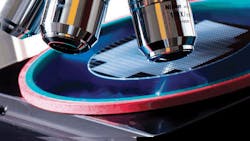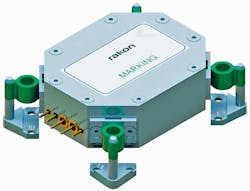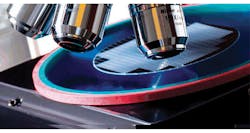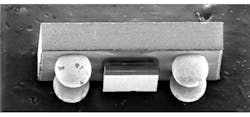Timing Requirements Change, and So Do Voltage-Controlled Oscillators
This file type includes high resolution graphics and schematics when applicable.
Timing requirements for modern commercial electronics are demanding more for the same cost in a smaller footprint. Conversely, military and aerospace applications are looking for timing products that have advanced in thermal, vibration, and aging stability. To meet these demands while satisfying the increasing need for adaptable microwave/RF solutions, frequency-control companies are producing more advanced voltage-controlled oscillators (VCOs) from a myriad of technologies.
The leading technologies for small-footprint VCO technology include traditional quartz-crystal, surface-acoustic-wave (SAW), and microelectromechanical-systems (MEMS) oscillators. These technologies operate using different material properties of disparate resonator devices. As a result, their performance and performance-enhancing technologies vary.
Voltage-controlled crystal oscillators (VCXOs) use a precisely cut quartz-crystal element that resonates at a set frequency--based on the crystal’s geometry--when exposed to an electric field. Crystal oscillators have been manufactured for over 80 years. They are the most common oscillator technology for clock generation in the few hundred megahertz. VCXOs, which offer jitter performance around 0.5 ps-RMS, are used with discrete phase-locked-loop (PLL) circuitry. The crystal resonator within a VCXO is highly sensitive to the noise from the electric field that induces vibration. These oscillators often require filtering and regulation for their power supplies.
Additionally, VCXOs are subject to vibration and temperature sensitivities. Because crystal oscillators have long been the dominant technology in this space, there are many techniques used to compensate for these drawbacks and sensitivities (Fig. 1). Companies like Rakon, Synergy, Kyocera, and Pletronics manufacture VCXOs with optional features that increase the stability of the VCXO in the face of environmental stresses. Yet such stability comes at the expense of cost, footprint, and lead times. These techniques include temperature control, oven packages, low-pass filtering for vibration, and amplification.
Voltage-controlled SAW oscillators (VCSOs) are generally used for applications in the high-frequency domain. They target clock generation or applications requiring low phase noise and jitter performance. Typically, VCSOs operate from a few hundred megahertz to a few gigahertz, depending upon the frequency multiplication used. VCSOs often have phase-noise figures below -90 dBc/Hz at 1 kHz and jitter below 0.3 ps-RMS. Because VCSOs only resonate at a single frequency of operation, some applications may require several resonators packaged together to service multiple frequencies (Fig. 2). Often, VCSOs are used in discrete PLL applications as local oscillators requiring low jitter, low-noise clocks, and clock recovery systems.
Because the resonator material behavior changes with temperature, the resonant behavior of VCSOs is generally susceptible to temperature drift and variations. Additionally, the voltage produced from a SAW resonator is comparably weak and requires high-gain amplification. According to James Wilson, marketing director of timing products for Silicon Labs, “VCSOs are forced to be designed with high-gain circuitry to provide sufficient or absolute pull range. Also, high control-voltage gain linearity increases variations in PLL bandwidth, which can impact system-level performance including the system bit-error rate.” As a function of the complex manufacturing process used to produce SAW resonators, long and potentially variable lead times beyond 10 weeks are possible. Companies like Api Technologies, Vectron, Silicon Labs, Epson, and Crystek manufacture a variety of VCSOs.
This file type includes high resolution graphics and schematics when applicable.
This file type includes high resolution graphics and schematics when applicable.
A more recent addition to the VCO family is the MEMS VCO. These VCOs use micro-sized mechanical vibrators that can be developed using CMOS processing on chips and in extremely small-footprint packages (Fig. 3). The VCOs operate from as low as 1 MHz to a few hundred megahertz. MEMS VCOs are generally low-voltage and low-power devices that can be made in large volume, at low pricing, and with very short lead times compared to other VCO technologies. Typically, these benefits have come at the cost of higher jitter and phase noise—several ps-RMS. Manufacturers of MEMS VCOs include Silicon Labs, Vectron, Micrel, and SiTime.
As a function of the highly integrated CMOS technology, MEMS VCOs can be augmented by sophisticated circuit techniques. SiTime recently developed CMOS MEMS VCOs that can supposedly match and even exceed the jitter response of VCXOs. “MEMS originally had very limited capability. But now, it is at the snapping point where the MEMS capability is exceeding the quartz performance,” said Aaron Partridge, founder and chief scientist of SiTime. In packages measuring 5 x 3.2 mm or 7 x 5 mm, the firm’s new VCOs provide a pull range from 25 to 1600 ppm with jitter performance under 0.5ps-RMS.
Among the additional benefits of MEMS VCO technology are lower power, a smaller footprint, lower parasitics, and the potential for direct programmability. Partridge notes, “One of the factors that limit the quality of signals from oscillators is the stray capacitance. With a crystal oscillator in a ceramic package, the capacitance can be very high. With MEMS oscillators, the capacitance is derived from small bond wires and is very low. This low stray capacitance provides advantages in terms of signal quality.”
With other VCO technologies, a digital signal traditionally controls an analog-to-digital converter (ADC). That ADC, in turn, uses an analog signal to control the VCO. Another method is to control a PLL with a direct digital stream, which could reach resolutions of parts per billion. This new technique prevents any analog noise from the control signal entering the signal stream. For example, the MEMS resonators in the latest SiTime VCOs are adjusted using a digitally controlled PLL.
With SAW or crystal-based technologies, the tight integration of advanced control circuitry requires additional and complex manufacturing steps. SAW and crystal resonators also are reliant on specialized manufacturing techniques to construct the resonators. The resulting higher cost and longer lead times are less desirable in a market that continues to demand shorter design and production cycles. It also should be noted that many applications, such as aerospace and military, may require much higher-performing and specialized functionality from their VCOs without being driven by cost, footprint, or fast-paced market needs. For telecommunications applications, in contrast, the benefits of technologies that can integrate with CMOS processes is becoming increasingly apparent as market demands drive down costs, size, and lead times for almost all commercial RF/microwave components.
This file type includes high resolution graphics and schematics when applicable.
About the Author
Jean-Jacques DeLisle
Jean-Jacques graduated from the Rochester Institute of Technology, where he completed his Master of Science in Electrical Engineering. In his studies, Jean-Jacques focused on Control Systems Design, Mixed-Signal IC Design, and RF Design. His research focus was in smart-sensor platform design for RF connector applications for the telecommunications industry. During his research, Jean-Jacques developed a passion for the field of RF/microwaves and expanded his knowledge by doing R&D for the telecommunications industry.




